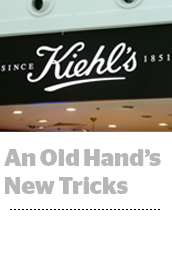 Kiehl’s, a high-end cosmetics brand and the country’s third-oldest retailer, has traditionally prioritized experiential branding over broadcast or online ad reach.
Kiehl’s, a high-end cosmetics brand and the country’s third-oldest retailer, has traditionally prioritized experiential branding over broadcast or online ad reach.
While that preference isn’t changing, Kiehl’s is becoming a more digital, data-driven business.
The brand started running programmatic campaigns in late 2016, and previously did little to no online media buying, said Julia Mavrodin, assistant VP of ecommerce and digital marketing. Still, ecommerce accounts for almost half the company’s business, and online engagement is up despite the relatively low ad spend.
Many of Kiehl’s competitors have tied their growth to data-driven advertising, she said.
Direct-to-consumer razor and skincare startups like Harry’s and Unilever’s Dollar Shave Club are heavy programmatic and platform spenders because they need to coax potential customers through a subscription sales funnel. Other top startup cosmetics brands pump a third or more of overall revenue back into Facebook and programmatic advertising.
Longstanding Kiehl’s competitors have been challenged as well. During Procter & Gamble’s earnings report last week, company CFO Jon Moeller singled out Gillette, the world’s largest shaving brand, because it had been forced to reduce prices and is in the middle of a large marketing campaign to promote a new product line.
Kiehl’s high-end prices give less reason for broad reach advertising, but the brand’s relative non-reliance on paid media still “is an important differentiating factor” in terms of preserving profit margin a more intimate, word-of-mouth appeal to the brand, Mavrodin said.
Kiehl’s never spent more than $20,000 per month for mobile or display ads, according to data over the last year pulled from online ad tracking and analytics service Pathmatics. There were two months when the brand spent $30,000 and then $140,000 on desktop video inventory.
Startups like Harry’s and Dollar Shave Club spend hundreds of thousands of dollars per month on online ads, often more than $1 million, while Gillette spends millions of dollars per month.
Instead of “building out budgets based on reaching new customers,” Kiehl’s views advertising more as part of its investments in customer engagement, Mavrodin said.
For instance, the company launched a Facebook bot last year to message or send an offer to users within a geofenced proximity of a store. If it leads to a transaction, there’s a performance payout.
AdExchanger Daily
Get our editors’ roundup delivered to your inbox every weekday.
Daily Roundup
Kiehl’s is working on ways to apply the same Facebook chat and message capabilities to SMS text, which could boost store traffic and open an untapped pool of ecommerce buyers, Mavrodin said.
People with Apple Pay linked to messages, for instance, may end up being a frictionless group of auto-replenishment sign-ups.
There’s a risk in applying data to marketing and only thinking about return on ad spend, Mavrodin said, as most marketers do if their mandate is to drive ecommerce sales or attributable store sales.
Take Kiehl’s auto-replenishment service: It has the same subscription payment model as Harry’s or Dollar Shave Club, but instead of finding new customers with lookalike audiences or Facebook campaigns, Kiehl’s mostly pushes auto-replenishment to existing customers through email, Facebook messaging and SMS.
A regular shopper – someone who buys every year – and even a loyalty program member may not make much sense for auto-replenishment if, say, he or she tends to make big purchases once or twice a year around the holidays.
By badgering what may look like a good subscription funnel candidate with endless ads, Kiehl’s could drive away the customer, Mavrodin said, especially considering the company’s premium pricing and appeal.
An internal research project last year found upward of 40% of Kiehl’s customers value the efficiency and routine of a subscription service, she said. A customer fitting that profile, or one who buys the same product on a regular schedule, would be a good fit for auto-replenishment.
Again, this is a major cost-saver for Kiehl’s.
Direct-to-consumer brands like Harry’s and Dollar Shave Club must factor in painful expenses like customer acquisition budgets, high churn among sign-ups and product waste for free trials, said Greg Alvo, CEO of Kiehl’s commerce tech vendor OrderGroove.
“When we’re spending on media, we want to be buying against real lifetime value,” Mavrodin said.













